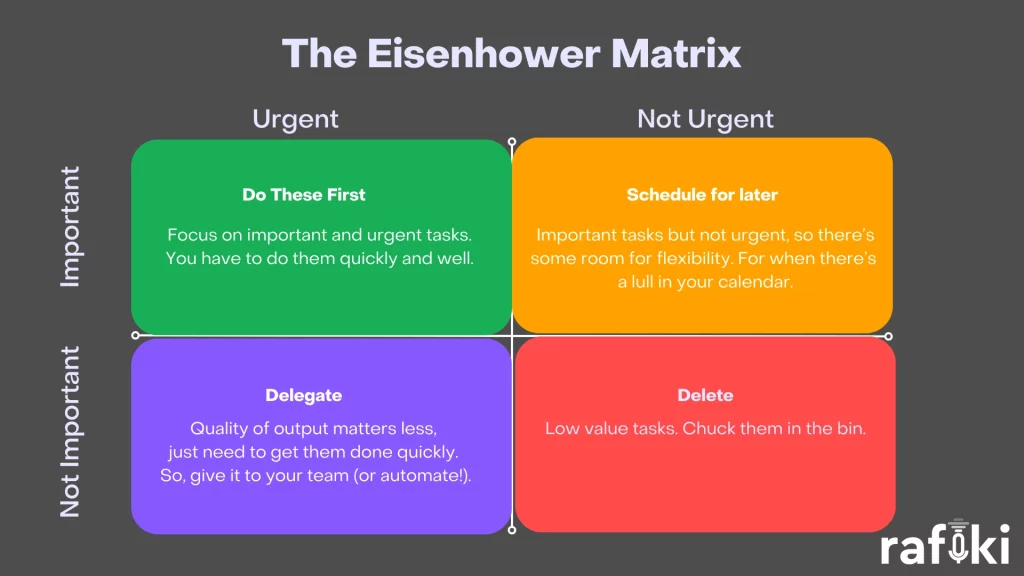Why Rafiki
Pricing


Pricing
Solutions

RevOps Leaders
Synchronize revenue generating functions

SDR Leaders
Get your team aligned and Coach your Reps 3x faster at scale

Sales Leaders
Unlock pipeline truth, drive confident forecasts

In the fast-paced world of sales, time is not just money—it's everything. Maximizing the amount of time spent on direct selling activities can dramatically increase the likelihood of meeting and surpassing sales targets. Studies show that top-performing salespeople spend up to 43% more time in front of customers than their peers, highlighting that face-to-face selling directly correlates with sales success. However, sales professionals often find themselves bogged down by a myriad of non-selling activities. From administrative tasks to unnecessarily long meetings, these activities, while sometimes necessary, do not directly contribute to closing deals and generating revenue. Understanding how to identify and reduce these non-selling activities is crucial for sales efficiency and effectiveness.
The goal is to streamline your workflow by reducing the time spent on tasks that do not impact your sales outcomes directly. This not only increases productivity but also allows for more strategic and focused selling efforts. According to a McKinsey report, improving the productivity of salespeople through better time management can lead to a 15-20% increase in sales efficiency.
In this blog, we'll explore seven practical steps that can help you cut down on non-selling activities, thus freeing up more time for what truly matters—selling. By focusing on these strategies, sales professionals can optimize their daily routines, enhance their performance, and ultimately drive better sales results.
To enhance productivity and focus more on selling, it's crucial for sales professionals to first identify what constitutes non-selling activities. These are tasks that do not directly contribute to making sales or building customer relationships, yet often consume a significant portion of the workday.
Non-selling activities typically include administrative duties, extensive paperwork, and data entry. They also involve internal meetings that do not pertain to active sales strategies. Additionally, managing emails that do not lead directly to sales is included. These tasks maintain the operations of a sales department or organization. However, they do not directly impact sales outcomes. They can detract from time that could be better spent engaging with clients.
To effectively reduce non-selling activities, you first need to conduct an audit of your daily and weekly tasks. This can be done by:
After identifying and categorizing non-selling activities, the next step is to determine which tasks can be eliminated or redesigned to be more efficient. Consider whether:
By identifying non-selling activities and understanding how they fit into your daily routine, you can begin to make informed decisions about how to reduce these tasks or handle them more efficiently. This initial step is essential in paving the way for a more focused and productive sales strategy, allowing more time to be spent on activities that directly impact sales success.
Effective task prioritization is essential for sales professionals who aim to maximize their productivity and focus on activities that directly lead to sales. One effective tool for managing tasks is the Eisenhower Box, also known as the Eisenhower Matrix. This prioritization strategy helps individuals categorize tasks based on their urgency and importance. It allows them to decide more effectively on which tasks to focus immediately, schedule for later, delegate, or eliminate altogether.
The Eisenhower Box divides tasks into four quadrants:

After categorizing tasks using the Eisenhower Matrix, focus primarily on tasks that are either urgent and important or important but not urgent. These are the activities that have the most significant impact on your sales goals. By prioritizing these tasks, you ensure that your energy and time are invested in areas that drive sales and contribute to your overall targets.
Moreover, by scheduling important but not urgent tasks, you can plan your workflow in a way that maintains a steady progression towards your goals without last-minute pressures. This strategic approach not only enhances your efficiency but also reduces stress, allowing for a more focused and productive sales process.
Implementing this method of prioritization can transform how you manage your day-to-day activities, leading to significant improvements in performance and sales outcomes. By focusing on what truly matters, you can minimize wasted time. This allows you to channel your efforts towards activities that directly contribute to your success in sales.
Automating routine tasks is a powerful strategy for sales professionals to increase their efficiency and spend more time on direct sales activities. Modern technology offers a variety of tools that can handle repetitive non-sales tasks, such as CRMs, scheduling apps, and sales intelligence tools. By leveraging these technologies, sales teams can drastically reduce the amount of time spent on administrative tasks.
A standout example of automation in the sales process is Rafiki, an advanced tool designed to streamline significant portions of a salesperson's workflow. Rafiki offers several automation features that specifically reduce non-selling tasks:

Automating these routine tasks can lead to significant benefits:
By implementing tools like Rafiki, sales professionals can transform their workflow, making it more efficient and effective. Automation not only helps in managing time better but also ensures that every minute spent is directed towards activities that contribute to sales success.
Effective delegation is crucial for sales professionals to focus on high-impact activities and enhance team efficiency. It involves identifying tasks that others can handle and assigning them to the right team members. This allows leaders to concentrate on core responsibilities like closing deals and strategizing.
Delegating effectively maximizes team productivity and fosters professional development. It helps maintain focus on strategic sales activities while building a supportive and skilled team ready to take on increasing responsibilities.
Time blocking is an effective method for managing the day efficiently and enhancing productivity, particularly in sales. By allocating specific time slots to various types of tasks, sales professionals can ensure that they focus adequately on essential activities. This approach also prevents the neglect of necessary administrative duties.
By dedicating specific times to complete necessary but non-selling tasks, sales professionals can create a more disciplined, focused workday. This method helps in reducing the mental clutter of constantly switching tasks, which can drain energy and decrease efficiency. It ensures that the majority of the day is spent on activities that directly contribute to sales success, maximizing productivity during peak performance periods.
Time blocking not only enhances day-to-day productivity but also provides clear boundaries that help maintain work-life balance, ultimately leading to sustained performance and reduced burnout.
Reducing the duration and frequency of meetings can significantly increase the time available for direct sales activities. Efficient meetings are key to maintaining productivity and focus throughout the sales team.
Shorter, more focused meetings free up valuable time for engaging with clients and pursuing new sales opportunities. They also minimize disruptions in daily work, leading to greater overall efficiency and productivity within the sales team.
Continuous monitoring and adjustment of your approach to managing non-selling activities is crucial for sustained sales success. This proactive step ensures that your strategies remain effective and responsive to changing demands.
Regularly revisiting and refining your strategies helps maintain a high level of productivity and focus on sales activities. It prevents stagnation and ensures that your practices stay relevant and effective, ultimately driving better sales outcomes and team performance.
Implementing these seven steps to cut down on non-selling activities is a dynamic way to enhance your sales performance. By identifying and minimizing unnecessary tasks, prioritizing crucial activities, automating routine processes, delegating effectively, managing your time through blocking, optimizing meetings, and continually monitoring and adjusting your approach, you can significantly increase the amount of time available for engaging directly with clients and closing sales.
Adopting these strategies requires commitment and a willingness to adapt, but the benefits are clear: increased efficiency, improved sales outcomes, and a more focused and motivated sales team. Remember, the key to success in sales is not just working harder but working smarter. By refining your workflow and eliminating inefficiencies, you free up resources to concentrate on what truly matters—growing your business and achieving your sales targets.
Less Admin, More Selling
We encourage you to implement these steps gradually, monitor the impacts, and adjust as necessary to fit your unique sales environment. With persistence and dedication, you can transform your sales process into a lean, focused engine that consistently drives revenue and success.